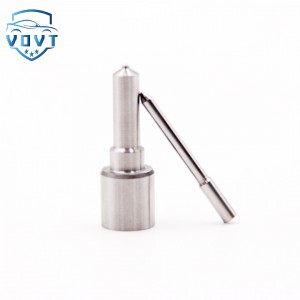New High Quality Diesel Nozzle L325PBC for Injection Nozzle Diesel Engine Parts
Products Description
| Reference. Codes | L325PBC |
| Application | / |
| MOQ | 12PCS |
| Certification | ISO9001 |
| Place of Origin | China |
| Packaging | Neutral packing |
| Quality Control | 100% tested before shipment |
| Lead time | 7~15 working days |
| Payment | T/T, L/C, Paypal, Western Union, MoneyGram or as your requirement |
Fuel injector nozzle
Classification
Hole-type fuel injector: The design of the spray hole can accurately adapt to the combustion chamber. Multiple spray holes can be designed according to different engine requirements to achieve more uniform fuel atomization and a more ideal injection angle to ensure that the fuel is evenly distributed in the combustion chamber. It is usually used in engines with high requirements for injection quality and complex shapes in the combustion chamber, such as some high-performance gasoline engines and some diesel engines.
Axle-pin fuel injector: A shaft pin extends downward below the sealing cone surface at the lower end of the needle valve. The shaft pin has an inverted cone and a cylindrical shape. The shaft pin extends out of the spray hole, making the spray hole a circular slit. Generally, there is only one spray hole with a diameter of 1-3mm and a low injection pressure of 12-14MPa. Its characteristics are that the spray hole has a large diameter, which is easy to process and not easy to clog. The start and stop of the injection are crisp and there is no oil dripping phenomenon, but it cannot meet the needs of combustion chambers with special requirements for injection quality. It is often used in some diesel engines with relatively low requirements for injection accuracy.
Working process
Take the common electronically controlled fuel injector as an example, its working process is as follows:
Fuel supply: The fuel is delivered from the fuel tank to the fuel rail through the fuel pump, forming a certain pressure to provide pressure guarantee for the normal operation of the fuel injector.
Control signal: The engine control unit (ECU) monitors the engine's working conditions in real time through sensors, including speed, load, temperature and other information, and then calculates the optimal fuel supply and sends corresponding control signals to the fuel injector.
Injection process: Under the control of the ECU, the solenoid valve in the fuel injector opens, and the fuel is injected into the cylinder through the fuel injector. When the electromagnetic coil is energized, a magnetic field suction is generated, causing the needle valve to overcome the spring force and rise. The fuel is ejected at high speed through the annular gap between the needle pin at the head of the needle valve and the spray hole to form a mist. After being fully mixed with the air, it is ignited (gasoline engine) or self-combusted (diesel engine) through the ignition system, thereby driving the piston to move and complete the engine's working cycle. When the ECU stops sending signals, the electromagnetic suction disappears, and the needle valve returns to the closed state under the action of the return spring, and the fuel injection stops.
Factors affecting performance
Injection pressure: The higher the pressure, the better the fuel atomization effect, which can make the fuel and air mix more fully, but too high pressure will increase the load and wear of the fuel system. Different types of engines and injector designs need to match the appropriate injection pressure. For example, the injection pressure of gasoline engines with direct injection in the cylinder is generally 120-200Bar, while the injection pressure of gasoline engines with intake manifold injection is usually 2.5-3.5Bar.
Number and diameter of spray holes: A large number of spray holes and a small diameter can make the fuel more evenly dispersed and the atomization effect better, but the processing difficulty and cost will also increase, and it is also more prone to clogging; a small number of spray holes and a large diameter will result in better concentration of fuel injection and stronger penetration, but it may cause uneven fuel distribution.
Response speed of needle valve: The rapid opening and closing of the needle valve can accurately control the start and end time of injection and achieve accurate injection amount control. If the needle valve responds slowly, it will affect the performance of the engine under different working conditions, such as causing problems such as insensitive acceleration and unstable idle speed.





















